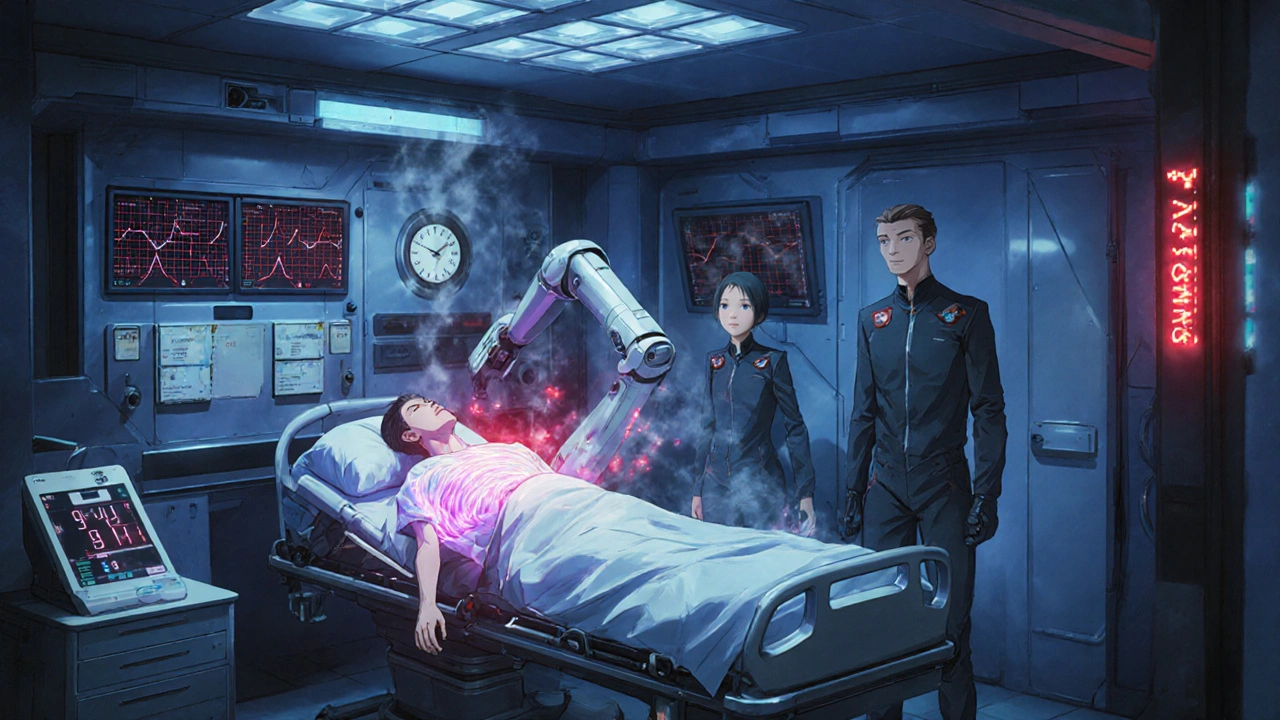When your chest hurts, it’s easy to panic. Is it heartburn? A pulled muscle? Or something life-threatening? The truth is, chest pain isn’t always a heart attack-but when it is, every minute counts. In the U.S., about 6 to 8 million people show up at emergency departments each year with chest pain. Only about 1 in 10 of them actually have a heart attack. But missing the other 9%? That’s where things go wrong.
What Chest Pain Really Means
Chest pain isn’t just a sharp stab or crushing pressure in the middle of your chest. It can feel like tightness, heaviness, or even a burning sensation. And it doesn’t even have to be in your chest. Many people with heart problems feel it in their jaw, neck, back, shoulders, or upper belly. Some don’t feel pain at all-they just get suddenly short of breath, dizzy, or exhausted. These are called anginal equivalents, and they’re just as dangerous.Here’s what real cardiac chest pain usually looks like:
- Pressure or squeezing, like someone is sitting on your chest
- Spreading to your left arm, jaw, or back
- Worsens with activity and doesn’t go away with rest
- Followed by nausea, cold sweat, or vomiting
- Often comes with extreme fatigue, even if you didn’t do anything
It’s not always dramatic. Some people, especially women and older adults, have subtle symptoms. A 72-year-old woman might think she’s just got the flu because she’s tired and nauseous. A 58-year-old man might brush off jaw pain as a toothache. That’s why you can’t rely on how it feels alone.
When You Must Go to the Emergency Department
You don’t need to be sure it’s a heart attack. If you’re unsure, go. The guidelines are clear: when in doubt, get checked. Here’s when you should call 911 right away-not drive yourself:- Chest pain lasting more than 10 minutes, especially if it’s new or worsening
- Pain that comes with sweating, dizziness, or fainting
- Difficulty breathing, especially if you’re not exerting yourself
- Heart rate over 100 beats per minute with no clear cause
- Low blood pressure (below 90 systolic)
- Crackling sounds in your lungs or swelling in your legs
- Any chest discomfort if you have diabetes, high blood pressure, high cholesterol, or a family history of early heart disease
These aren’t just suggestions. They’re red flags backed by decades of data. A 2021 guideline from the American Heart Association and American College of Cardiology says patients with these signs need to be evaluated in an emergency department immediately. Why? Because delays cost lives. If you drive yourself, your risk of complications goes up by 25-30% compared to using an ambulance.
And yes, calling 911 matters. Emergency crews can start monitoring your heart and give you aspirin or nitroglycerin on the way. They can send your ECG to the hospital before you even arrive. That cuts down your time to treatment by 20 to 30 minutes. That’s not just convenient-it’s life-saving.
What Happens in the Emergency Department
When you get to the ER, they don’t waste time. The first thing they do? Get an ECG within 10 minutes of your arrival. That’s not optional-it’s required by national standards. The ECG is cheap, fast, and tells them more than you’d think. A heart attack might show up as ST elevations (STEMI), which means immediate surgery. Or it might be subtle-like slight changes in the T-wave-that only a trained eye catches.Next, they draw blood for a high-sensitivity cardiac troponin test. This protein leaks into your blood when your heart muscle is damaged. Two tests, one hour apart, can rule out a heart attack in 70-80% of cases. That’s why some ERs can send you home in just two hours-if everything looks clear.
They’ll also check your vital signs: breathing rate, blood pressure, oxygen levels, and heart rhythm. If you’re sweating, pale, or looking unwell, they’ll treat you as high-risk-even if your ECG looks normal. That’s because your overall appearance, or clinical gestalt, is one of the most powerful tools doctors have.
For people who don’t have a clear heart attack but still have risk factors, they might order a CT scan of the heart (CCTA) to check for blocked arteries. Or they might schedule a stress test later. But if you’re unstable, they won’t wait. They’ll take you straight to the cath lab.

What You Should Avoid
Don’t wait to see if it goes away. Don’t take antacids and hope it’s just acid reflux. Don’t call your primary care doctor first if you’re having active symptoms. That’s a common mistake. Outpatient clinics aren’t equipped to handle emergencies. They don’t have ECG machines ready at 2 a.m., and they can’t give you clot-busting drugs.Also, don’t rely on old troponin tests. Some clinics still use outdated versions that take hours to give results. The new high-sensitivity assays are accurate within 1-2 hours. If your doctor uses an older test, they might miss a heart attack.
And no, coughing hard or breathing deeply won’t make heart pain go away. That’s a myth. If you’re having chest pain and you’re not sure why, don’t try to self-diagnose. The consequences are too high.
Who’s at Risk-and Who Isn’t
You might think only older men with high cholesterol are at risk. But that’s outdated. In 2025, heart attacks are rising in people under 40, especially women and those with obesity, diabetes, or smoking history. Even people who exercise regularly can have blocked arteries. Genetics plays a big role.On the flip side, not every chest pain is dangerous. If you have:
- Pain that only happens when you press on your chest
- Pain that lasts seconds and comes and goes randomly
- Pain that’s clearly tied to a recent injury or muscle strain
- Pain that improves with antacids and never returns
Then it’s probably not your heart. But even then-if you’ve never had this before, or you’re over 50 and have risk factors-it’s still safer to get it checked.
There’s also a group called INOCA-people with ischemia but no blocked arteries. Their symptoms are real, but the cause is different: small vessel disease, stress-induced spasms, or hormonal changes. These patients often get misdiagnosed because standard tests don’t pick it up. If you’ve had repeated chest pain with normal angiograms, ask about INOCA. It’s becoming more common.

What Comes Next After the ER
If you’re sent home, don’t assume you’re fine. Many heart attacks happen days after the first warning signs. You’ll need follow-up care: a cardiologist visit, blood work, and possibly a stress test or echocardiogram. You might be prescribed aspirin, statins, or beta-blockers. Lifestyle changes-quitting smoking, eating less processed food, walking daily-are non-negotiable.If you were hospitalized, you’ll likely get a cardiac rehab referral. These programs are proven to cut your risk of another event by 25%. And they’re covered by most insurance.
Even if you’re low-risk, the ER visit is a wake-up call. Use it. Talk to your doctor about your cholesterol, blood pressure, and weight. Don’t wait for the next pain to strike.
What’s Changing in 2025
By 2025, most U.S. hospitals will use AI to help read ECGs. Early studies show AI spots subtle signs of heart damage that even experienced doctors miss-98.5% accuracy, compared to 85% for humans. That means faster, more accurate diagnoses.Also, more people are being discharged from the ER within hours thanks to faster troponin tests. The goal isn’t to admit everyone-it’s to find the 10% who need help and let the rest go home safely.
But the biggest change? Awareness. More people are learning to recognize the signs. More 911 dispatchers are trained to ask the right questions. And more families are talking about heart health before it’s too late.
Can chest pain be caused by something other than a heart attack?
Yes. Chest pain can come from muscle strains, acid reflux, anxiety, lung infections, or even shingles. But because heart-related causes are life-threatening, every case needs to be evaluated by a medical professional. Never assume it’s "just" indigestion or stress.
Should I drive myself to the hospital if I have chest pain?
No. Driving yourself increases your risk of complications by 25-30%. Emergency medical services can start treatment on the way, send your ECG to the hospital, and alert the cardiac team. That saves critical minutes. Always call 911.
Is an ECG enough to rule out a heart attack?
Not always. Some heart attacks don’t show up on the first ECG. That’s why doctors take blood tests for troponin and repeat the ECG every 15-30 minutes if symptoms continue. A normal ECG doesn’t mean you’re safe-it just means you need more tests.
Can young people have heart attacks?
Yes. While less common, heart attacks in people under 40 are rising, especially among those with obesity, diabetes, smoking habits, or genetic conditions. Symptoms in younger people can be atypical-like extreme fatigue or nausea-so they’re often missed.
What’s the HEART score, and how does it help?
The HEART score is a tool doctors use to assess your risk: History (your symptoms), ECG findings, Age, Risk factors (like smoking or high blood pressure), and Troponin levels. A score of 0-3 means low risk, 4-6 is intermediate, and 7-10 is high risk. It helps decide who needs immediate care and who can go home safely.
If I’ve had chest pain before and it was just heartburn, should I ignore it this time?
No. Past episodes don’t guarantee future ones. Heart attacks can happen suddenly, even if you’ve had "false alarms" before. Each episode should be treated as a new event until proven otherwise. Don’t rely on history-rely on medical evaluation.
Do I need to go to the ER if I only have mild discomfort?
If the discomfort is new, lasts more than 10 minutes, or comes with other symptoms like sweating or nausea-even if mild-you should go. Mild doesn’t mean harmless. Many people who delay care because "it’s not bad enough" end up with worse outcomes.

9 Comments
Kezia Katherine Lewis
Cardiac chest pain presentation is highly heterogeneous, particularly in postmenopausal women and diabetics due to autonomic neuropathy dampening nociceptive signaling. The presence of anginal equivalents-like isolated dyspnea or fatigue-should trigger the same emergency response as classic substernal pressure. High-sensitivity troponin assays with serial sampling have revolutionized early rule-out protocols, reducing unnecessary admissions while maintaining safety margins. Clinical gestalt remains indispensable when ECG and biomarkers are inconclusive.
Henrik Stacke
Blimey, this is the most sensible, well-structured piece on chest pain I’ve read in years. The bit about calling 911 instead of driving? Absolute gold. I once knew a chap who drove himself to A&E with what turned out to be an STEMI-he nearly died because he waited too long to stop for petrol. Emergency crews aren’t just transport-they’re mobile intensive care units. If you’re in doubt, just bloody call them. No regrets.
Manjistha Roy
Every single point here is critical. Do not ignore symptoms because they are mild. Do not assume past episodes mean this is the same. Do not rely on home remedies. Do not delay. Do not drive yourself. Do not wait for your primary care doctor to open. Do not dismiss fatigue or nausea as stress. Do not assume you are too young. Do not hope it goes away. Medical evaluation is non-negotiable when cardiac origin is possible. Period.
Jennifer Skolney
This post literally saved my life. I had jaw pain last year and thought it was a toothache-turned out it was a mini heart attack. I’m alive because I finally listened to this exact advice. If you’re reading this and you’re scared to go to the ER? Go anyway. You’ll thank yourself later. ❤️
JD Mette
Good summary. The part about INOCA is often overlooked. Many patients get dismissed after normal angiograms, but their symptoms are real. Small vessel dysfunction is underdiagnosed, especially in women. It’s frustrating when you’re told it’s all in your head-but you’re not. The system needs to catch up.
Olanrewaju Jeph
It is imperative to emphasize that self-diagnosis of chest pain is not only unwise, it is potentially lethal. The clinical presentation of myocardial ischemia varies significantly across demographic groups. Therefore, any individual presenting with unexplained chest discomfort, regardless of age or perceived risk profile, must seek immediate professional medical assessment. Delayed intervention correlates directly with increased morbidity and mortality.
Kane Ren
People think heart attacks are dramatic, like in the movies. But mine? I just felt like I’d run a marathon at 3 a.m. with no sleep. No pain. Just… exhausted. And dizzy. And weirdly nauseous. I thought I was coming down with something. Turns out, my heart was screaming. Don’t wait for the movie version. If something feels off-go. You’ve got nothing to lose and everything to gain.
Charmaine Barcelon
Ugh, I can’t believe people still drive themselves. Are you serious? You think you’re being brave? You’re being reckless. And don’t even get me started on those who say, ‘I had heartburn before, it’s fine.’ You’re not a doctor. You’re not a robot. You’re a human with a heart that could stop at any second. Get. Help. Now. Stop being lazy. Stop being scared. Stop being dumb.
Karla Morales
Let’s analyze this with data: 85% of ER chest pain cases are non-cardiac, but the 15% that are? They kill. AI-enhanced ECG interpretation reduces false negatives by 13.5% compared to human-only reads. High-sensitivity troponin cuts time-to-rule-out from 6 hours to 1. That’s a 83% efficiency gain. But here’s the real metric: survival. Patients who use EMS have a 22% higher 30-day survival rate. So yes-calling 911 isn’t just smart. It’s statistically superior. 📊❤️